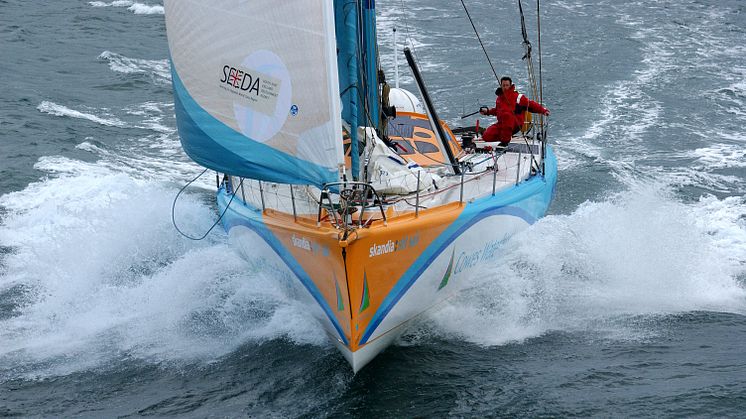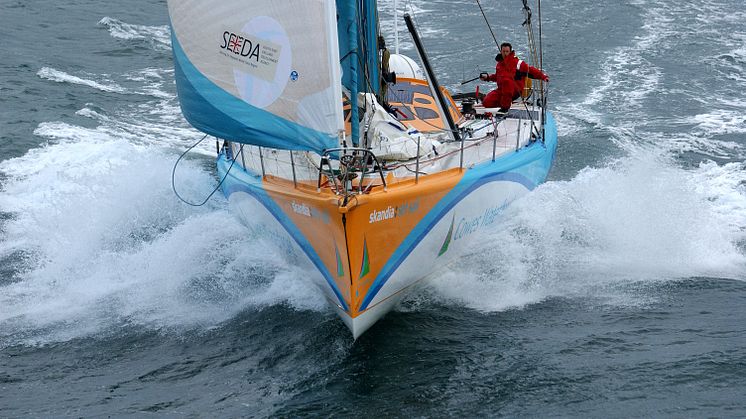
Blog post -
Next Ocean Race Editions will Showcase the Amazing Possibilities of a New Era of Global Yachting Connectivity
From faster performance and enhanced onboard safety, to fascinating story-telling and insight for the fans, Inmarsat Yachting Ambassador Nick Moloney explains how today’s ground-breaking satellite communication technology is transforming ocean racing
Connectivity as a tool in ocean racing has now reached a stage where the potential is truly astounding. By harnessing the cutting-edge advancements in satellite communication technology, the next generation of yachts racing around the planet have access to a level of connectivity that provides exceptional reliability and coverage, dramatically changing life onboard for the teams, the level of technical support and safety, the involvement of race control and the connection with the fans.
I believe the most modern expression of where the possibilities are today was led by Inmarsat’s support in the 2017-18 edition of The Ocean Race, which was simply ground-breaking and by far the strongest connection to life onboard a yacht racing around the world that we have ever seen. Teams were able to utilise the technology to enhance performance while also producing incredibly engaging content and footage for the fans and the media, such as the footage of racing in the Southern Ocean that was livestreamed from drones over Inmarsat’s satellite network.
However, with the first ever Ocean Race Europe getting underway tomorrow (Saturday 29 May), followed by the next edition of the round-the-world Ocean Race in 2022-23, I predict that we are on the verge of something even more special as exciting developments come to fruition. New opportunities brought about by telemetry, diagnostic tools and data analysis will make the boats faster, safer and more reliable, while connectivity in even the most remote regions will introduce additional insight and stories to bring the personalities and the challenge alive to people back home.
My first around-the-world race was in 1997 during a pioneering era in the use of satellite communications for racing yachts and the process was very new. We were using the communication tools for performance enhancement and weather information was evolving and developing very quickly. It also goes without saying that our safety parameters took a massive leap in the right direction. In the 1997-98 Whitbread Round the World Race, I was also handed the role of delivering content from the yacht in the form of text and video. This was an era where we did not have dedicated onboard reporters. We were sailors and this job in particular was a painful extra obligation to that of standing a general watch focused only on pushing the boat as hard as possible. But I grew to love the role and, on arrival after each leg of the race, I was often overwhelmed by the response from our sponsor, the event and the race fans about my diary updates or content sent from the boat to the shore. From this point, deliverables associated with sailing sports sponsorship expanded dramatically with an understanding that we were developing the capability to deliver stories and branded content to households, classrooms and boardrooms.
It is now clear that teams, such as those competing in the Vendee Globe solo for example, should never overlook how critical it is to invest in reliable connectivity. Having Inmarsat as a connectivity partner enables an unparalleled ability for the teams to tell their story and generate media for their sponsors; it gives them the ability to communicate with their shore team to problem solve; provides access to the absolute best weather and performance information; and could even aid the survival of themselves or a fellow competitor. Not investing in the right tools is a drastic oversight. Concentrating on pure boat construction and design performance elements alone will never win you an around-the-world-yacht race and these alone will never keep a family cruising remote waters safe.
Announced this month as The Ocean Race’s Official Satellite Communications partner for the sixth consecutive time, Inmarsat will undoubtedly help to create one of the most connected sporting events in history in 2022-23 as we enter this next phase of ocean race technology. Starting with advances in development and testing during construction and design of the boats, teams are now using telemetry and gathering tremendous amounts of data to upload from the boat in real time for analysis. Fibre optics in the foils and masts, for example, enable the technical personnel to check what the team are doing, the conditions and the key loads on equipment. The usage and lifetime of rigging and masts can be monitored effectively, which is vital whether it is a racing yacht or a cruising superyacht.
Data and monitoring capabilities make the boat faster and more reliable, but teams in the next Ocean Race, such as 11th Hour, are also using telemetry to collect and analyse important scientific data to help discover more about the health of our oceans. They will be communicating the message of sustainability to the fans, as well as reaching more people with story-telling and race updates.
The safety of the crew was always my main concern and it is incredibly reassuring for today’s teams that race control has their data, telemetry and position and can assist in an emergency. In the future, it is anticipated that connectivity will also help keep the athletes fit and healthy with the use of biometrics to provide more information, such as heart rate, stress levels and sleep patterns. These insights will also be fascinating for the fans back home.
I am pleased to be involved with Inmarsat’s new Digital Yacht initiative when I will be exploring all these issues and more over the next few months. The first video has been launched as part of our content on Performance Sailing and The Ocean Race, offering unique insight from 11th Hour’s navigator Simon Fisher as he prepares for the next edition of The Ocean Race. The new series, featuring a combination of online and live event formats, videos and supporting content, has been specifically tailored to help the superyacht, yachting, explorer and racing communities capitalise on the latest developments in onboard connectivity and harness the power of the new digital era.
- The first webinar in Inmarsat’s new Digital Yacht series - Digital Yacht: Performance Sailing and The Ocean Race - will take place on Thursday 10 June at 3:30pm, expanding on some of the topics covered in the new video The webinar will provide unique insight into the role of connectivity and digitalisation for elite sailing teams. For more details and to register, click here.
Ends
For more information or images, please contact:
Jules Riegal
Saltwater Stone
+44 (0)202 669244
j.riegal@saltwater-stone.com

